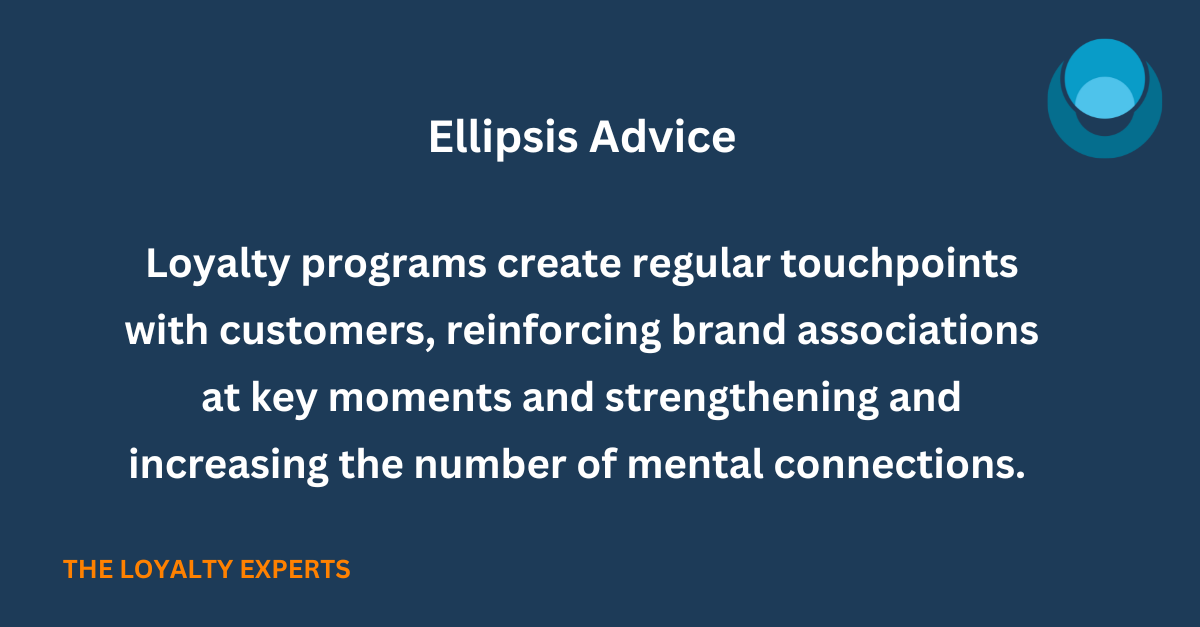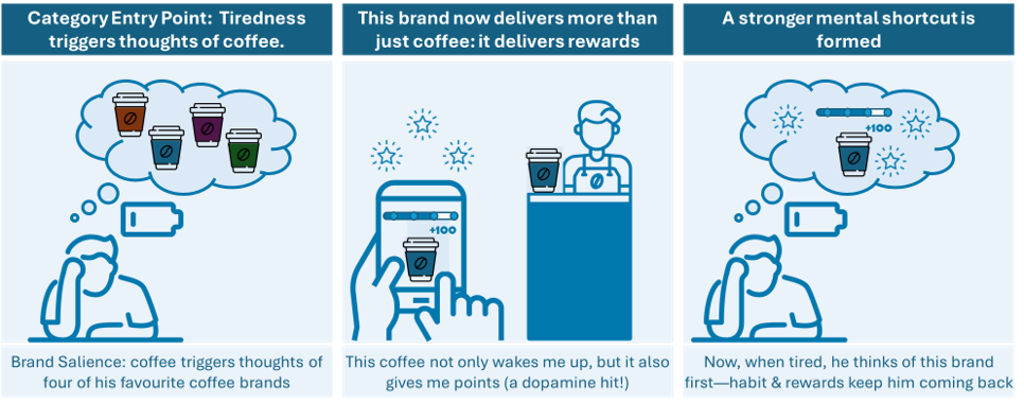
Customers Do. Good Loyalty Programs Reinforce It.
AI in business is creating a lot of hype, yet the human mind works in ways machines cannot replicate – we experience unconscious mental processes, emotional responses, and personal memories. These factors shape how we perceive and interact with brands.
For example, the smell of suncream might bring back memories of childhood beach vacations, immediately recalling a specific suncream brand, or a long, hot day at work may trigger the craving for a particular beer brand.
These associations are not accidental; they are the result of strategic brand building efforts that establish mental availability. When brands successfully embed themselves in memory structures, they become easily retrievable in relevant moments (such as purchasing decisions).
Research from the Ehrenberg-Bass Institute discusses the importance of this mental availability, which is also known as brand salience. This concept extends beyond awareness: brands need to be easily remembered to be considered.
Brands with high salience create multiple mental connections in consumers’ minds. Take your favourite brand of beer, for example. It doesn’t just come to mind when you want a drink – it is also linked to moments like unwinding after work or enjoying a hot summer day. Even when you are not actively thinking about beer, the brand stays relevant by embedding itself into these experiences.
This convergence of inputs is a category entry point (CEP); the mental cues that trigger the brand to be recalled in different contexts, making it more likely to be chosen.

The occasions that lead a customer to think about your category are the most important opportunities to associate your brand, making it the dominant, default, fast choice if a purchase results. The other 95% of the time, the customer is not thinking about your category or brand, so building mental availability is harder and more expensive.
The CEP is the trigger ("I need something for this situation")
Brand salience determines which specific brand(s) get activated by that trigger
Mental models are the frameworks consumers use to understand how products, categories, and consumption situations work
Reward programs associated with a category increase brand salience, adding additional attributes to the mental model – points pressure, endowed value, and even simple FOMO.
Other Examples of Category Entry Points in practice
Bedtime when the parent is deciding on breakfast choices for children next morning: Breakfast and being an Aussie kid (all ages, ear-worm jingle helps)
Festive Season: UK retailer and family love, (John Lewis) Santa Claus and a carbonated beverage
Mealtime as parents think about tomorrow’s grocery shopping: Fresh food, healthy eating
Approaching the end of a budget year, November and May: Whitepapers from Ellipsis on program strategy and design
Mother's Day, Valentine's Day, White Day (Japan): if you are retail chocolate or flowers
Category Entry Points are not Customer Touch Points, a CEP can be an occasion with no direct or immediate interaction with your company. CEP's trigger a mental association between a customer, a category of products/services they buy, and your brand/program. Ellipsis recommends that brands link themselves to as many CEPs as possible, as this strengthens mental availability and makes the brand easier to recall in key moments. However, there are pitfalls brands should be mindful of to avoid overcomplicating their strategy:
Don't mistake product features for mental triggers: a real CEP makes people naturally think of your program , while product specs rarely create these automatic mental connections.
Don't try to be everywhere at once: focusing on too many situations dilutes your brand's mental presence; better to dominate a few key moments than be forgettable in many.
We know that an excellent way to increase salience is through a loyalty program. Loyalty programs create regular touchpoints with customers, reinforcing brand associations at key moments and strengthening and increasing the number of mental connections. When customers interact with a loyalty program – whether checking their points, receiving a reward, or seeing a personalised offer, the brand becomes more deeply embedded in their mental framework.
Effective loyalty programs work particularly well for building salience because they connect the brand to positive experiences and tangible benefits. Each time a customer earns or redeems rewards; they experience a moment of satisfaction that strengthens the neural pathways linking the brand to positive feelings.
This is important because of the Law of Brand Substitution: customers have a repertoire of brands they purchase in each category. Adding rational and emotional weight to your proposition with rewards helps you get selected.
In fact, loyalty programs themselves serve as category entry points—connecting a brand to moments like earning rewards, redeeming points, or making repeat purchases. This strengthens mental availability and keeps the brand top of mind in a way that traditional marketing alone cannot.

Loyalty programs create entirely new entry points into categories that wouldn't naturally exist. If you have a loyalty credit card, it becomes a mental trigger every time you make a purchase. Your own birthday may even become a trigger, as you know you’re going to receive a birthday reward.
Frequent Flyer programs have achieved something remarkable; they have succeeded in making payments a category entry point. Customers choose particular retailers and specific payment cards to maximise the value they receive in the program every time they purchase in any category. ‘I could rent from Hertz or Avis, but AVIS gives me QFF points. Either way, I will pay with Amex, not my bank Mastercard, because I get more points.’ In this scenario, both renting a car and paying the bill become mental triggers that remind the customer of Qantas Frequent Flyer.
In a world increasingly dominated by technology, the human experience of brand relationships remains deeply important. While AI can analyse data and spot patterns, so far it lacks what makes brand connections work in humans: real experiences, feelings, and memories that create mental links between physical and mental situations and brands. As AI changes marketing, the basic reasons why customers choose certain brands still come down to our human ability to remember, feel, and make associations.
Download the file
Fill in the form below to gain access and download the file.